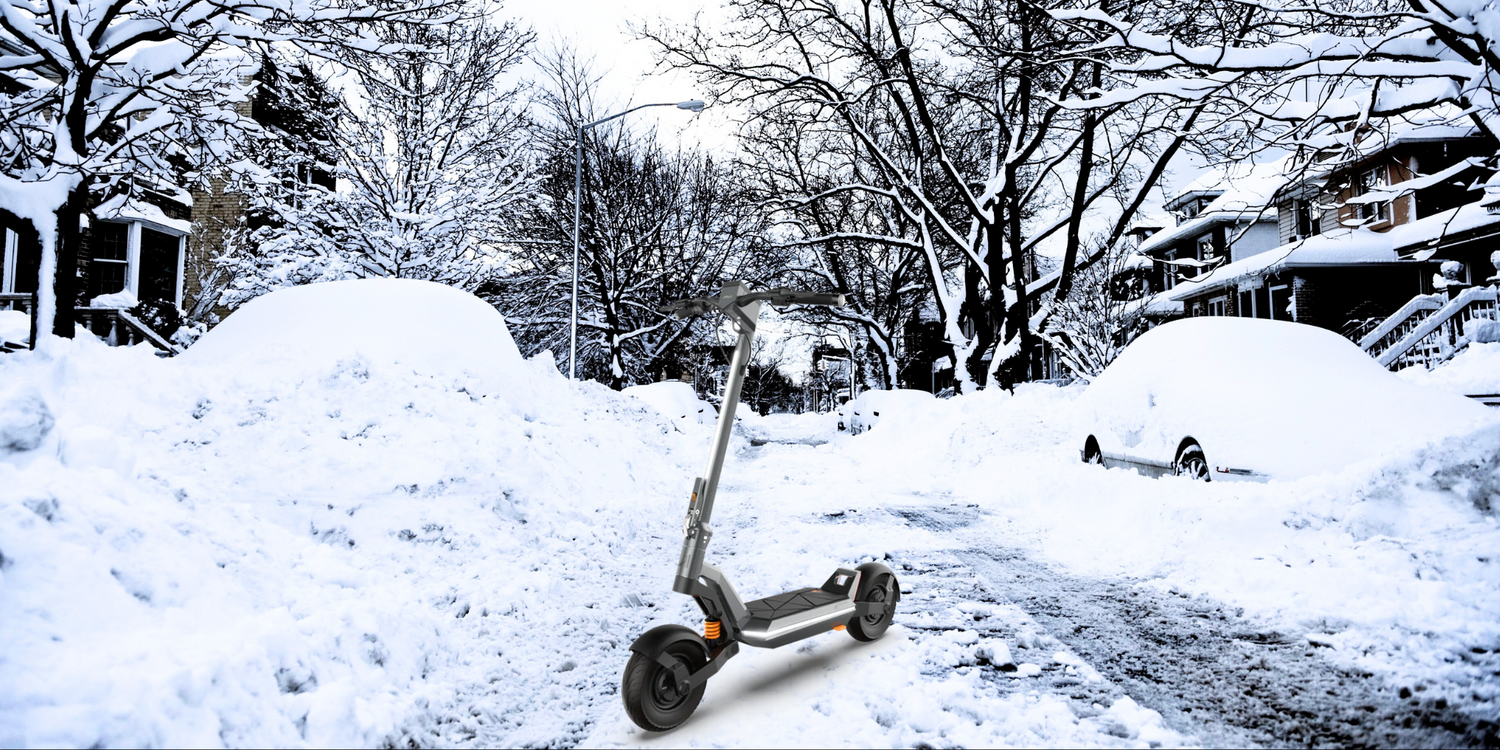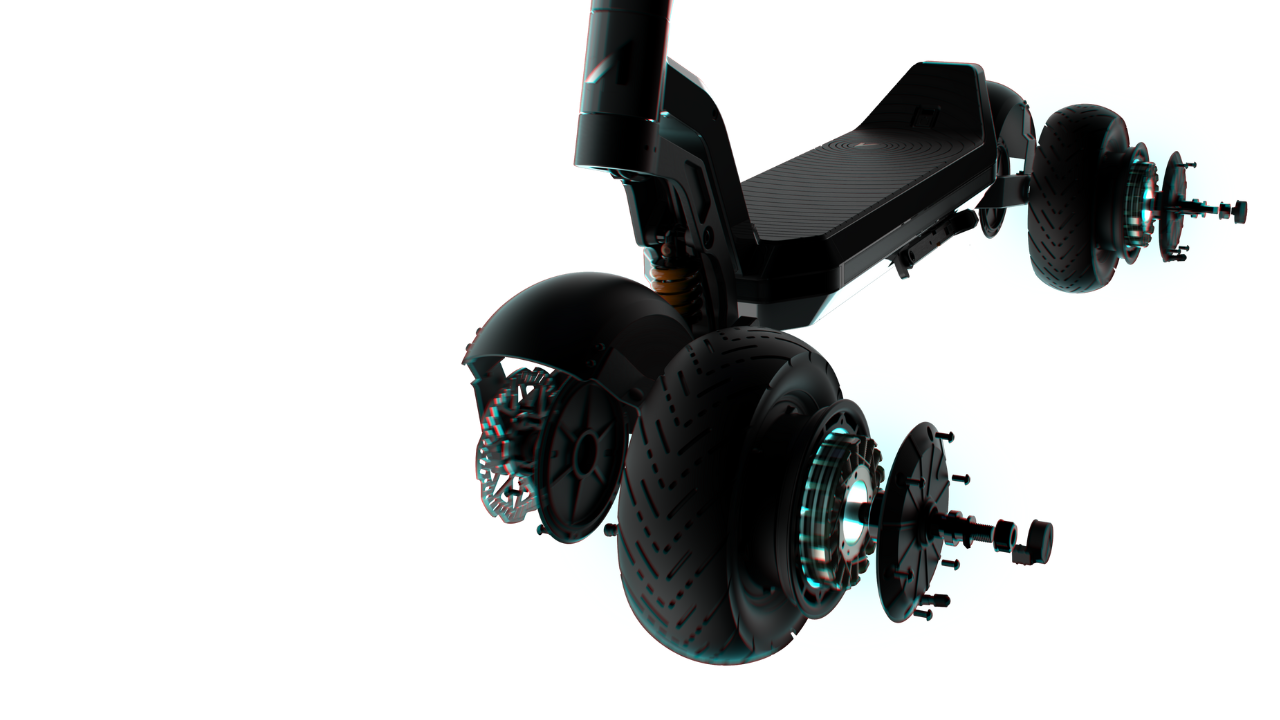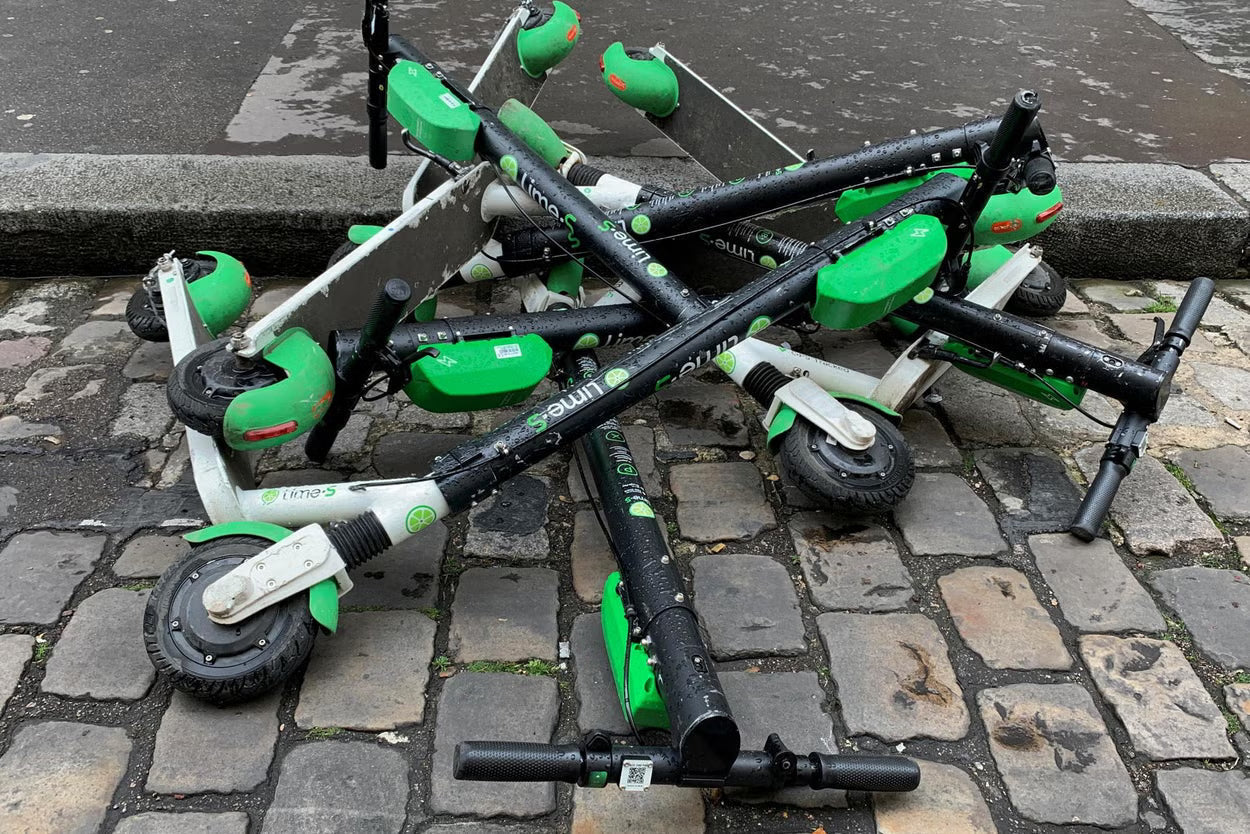So—you’re considering getting a new scooter during Black Friday (or maybe you’ve had yours for a while and are still in the honeymoon phase). You’re loving every ride, but winter is around the corner… and you’re wondering: do I really have to put my scooter away until spring?
The short answer: not necessarily.
Of course, “winter” doesn’t look the same everywhere. Winter in Montreal or Bismarck is a whole different story than “winter” in San Diego or Orlando. (And honestly—if you’re in Florida, why are you even Googling this? Just kidding. Kind of.) But seriously—if your winters mean mild temperatures and no snow, you’re good to go. Keep riding.
If, however, you’re somewhere with freezing temperatures—below 0°C / 32°F—or the kind of weather where slush and snow are a daily reality, then keep reading.
What Do We Mean by “Winter Riding”?
Winter riding usually comes down to two main challenges:
-
Temperature – Cold air negatively impacts your riding experience and your scooter’s battery.
-
Water (or snow) – Moisture adds risk, from slippery roads to potential water damage to your scooter.
The good news? Most scooters can handle winter conditions just fine—as long as you ride smart and take the right precautions. But here’s an important rule of thumb: if the weather feels rough while you’re walking, it’ll feel much worse on a scooter. Cold air hits harder at higher speeds, and slippery sidewalks turn even riskier on two wheels.
👉 Golden rule: If it’s too cold to walk, it’s definitely too cold to ride.
How to Ride Your Electric Scooter in Winter: Challenges & Safety Tips
Thinking about riding your scooter through the winter months? It’s definitely possible—but it comes with a unique set of challenges. From freezing temperatures to slippery roads, winter riding requires preparation, awareness, and the right gear.
Below, we break down the 5 biggest challenges of riding your scooter in winter—and how to overcome them.
1. Staying Comfortable: Clothing & Rider Readiness
For the best riding experience, proper clothing is key. And while it’s always smart to dress for the weather, it becomes critical in wet or cold conditions. Otherwise, what should be a fun ride can quickly turn into the worst experience ever.
A rider who’s shivering in the cold can’t operate their scooter smoothly, safely, or with good judgment. In addition to keeping your core warm and dry, don’t forget your hands and feet—your extremities lose heat the fastest, and cold fingers or toes can make riding miserable (and unsafe).
And let’s be honest—nobody actually enjoys being wet and freezing. Right? (If you do, we have questions…)
Here’s what’s important:
-
Dress in warm, waterproof layers.
Keep your core dry and warm, but don’t forget your extremities—hands and feet lose heat the fastest. -
Gloves and waterproof boots are essential.
👉 Remember: an uncomfortable rider is a distracted rider.
2. Cold Weather & Battery Performance
The impact of weather and temperature on the scooter can be more than you’d imagine; mostly due to low temperature impact on the battery packs. Typically, scooters can tolerate most temperatures that a rider will be comfortable riding in, however cold temperatures can have a significant impact upon Li-Ion battery life and health (all modern quality scooters use Li-Ion batteries). Especially when the scooter is stored or parked for a period of time and subjected to cold temperatures. Here’s a rule of thumb to know what temperature your scooter can take:
-
Slightly above Freezing (0–10°C / 32–50°F): Expect reduced range, as batteries are less efficient in cold conditions. Use slow charging instead of rapid charging when it’s cold.
-
Below Freezing (under 0°C / 32°F): Never charge a frozen battery. This can cause permanent damage—or even fire. Always warm the scooter indoors for at least 12 hours before charging.
-
Storage Tip: If you can’t store your whole scooter indoors, remove the battery and keep the battery a climate-controlled environment.
-
Tire Pressure: Cold weather lowers tire pressure—check and inflate regularly to maintain safe handling.
3. Rain, Snow, and Ice: Road & Scooter Protection
Water and moisture are the toughest challenges in winter—both for your scooter and for road conditions.
Road Conditions
-
Rain reduces traction.
Snow reduces it even more. -
Ice? Forget about it! That’s a no-go zone—two wheels and ice are a crash waiting to happen.
And it’s not just about your skill level. Other vehicles and pedestrians also struggle with reduced traction, which makes them unpredictable hazards. On top of that, visibility drops in cold, wet conditions—fogged glasses, rain, and splashes can impair both your vision and the vision of others. Always assume people around you are less aware of their surroundings—and less aware of you.
Water Exposure & Scooter Protection
When snow melts, it’s not just stability you need to worry about—your scooter itself is exposed to water, slush, mud, and dirt.
Apollo scooters are built tough with IP66 water and dirt resistance, but they’re not fully waterproof. That means:
-
Don’t submerge your scooter.
-
Avoid riding through deep puddles or heavy rain whenever possible.
Remember that road chemicals (like salt and de-icers) can cause corrosion over time.
👉 If you ride in wet conditions, always wipe down your scooter afterward to protect it from rust, salt, and chemical damage.
Debris and De-Icers on Winter Roads
Debris
The presence of rain, ice, and snow has a destructive impact on road surfaces. Causing breakup, particularly of asphalt pavements. In places with snow and ice, road chains and studs greatly increase road wear and pavement breakdown. This results in an increase in potholes and loose gravel on the road surface. Winter storms and run-off from road borders bring hazards such as twigs, branches, and trash onto the road surface. Increased attention to objects in your path is critical. Avoiding these hazards and adjusting your path is more often required in winter conditions than in other seasons.
De-icing
On some roads salt, or other de-icing materials are added to streets to help prevent ice formation and build up. They will be present on the road surface and in puddles and run-off. These chemicals tend to be corrosive and are potentially damaging to the scooter. Clean de-icer moisture and residue off the scooter as often and thoroughly as possible to keep it in proper operation and to reduce wear/corrosion.
Fewer daylight hours
Another exciting feature (not really) of wintertime is the reduction in daylight hours. If you are a commuter, it is most likely that you’ll be commuting (at least one way) in the dark for much of the winter. It is critical that your scooter has enough lighting so that you can operate safely outside of daylight hours.
Apollo scooters, especially the new Phantom series, have several strong lights that not only help light up the road in front of you, but also alert others to your presence. In the case of the Phantom 2.0, this lighting is bright and radiates 360 degrees. Adding lights to provide additional road visibility for you, the driver, as well as others to see you is always a good idea on any scooter at any time of year.
Winter Riding Gear
An often-overlooked part of rider safety—day or night, in any season—is your choice of riding gear. When you’re on a scooter, blending in is the last thing you want. Visibility can literally save your life. Bright colors, reflective details, and high-visibility vests make you stand out to drivers, cyclists, and pedestrians. A reflective vest, for example, is a simple but powerful “attention-getter” that ensures you’re seen from a distance.
Consider things like motorcycle armored type jackets, gloves, perhaps even pants with some reinforcement or armor. A more protective helmet is also a good idea in winter. This gear will not only offer greater safety in the event of a mishap, it will serve to protect you from the cold and from the elements as well.
Winter riding is possible, reasonable and even enjoyable
Winter conditions do require extra attention to the challenges that the season presents. Both the rider and the scooter should operate under best practices to meet these challenges. Increased attention to road conditions, weather-suitable riding apparel, visibility enhancements (like lighting and high vis clothing), and careful attention to scooter maintenance and battery care are important for successful winter scooter operations. Finally, knowing when the conditions are just not conducive to riding (such as potential for ice on roads and paths or severe winter storms) is critical
Happy and safe winter riding!






